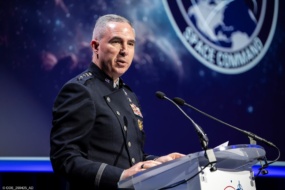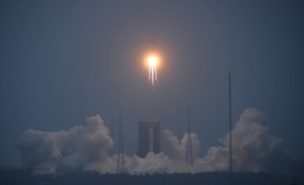US Transportation Secretary Sean Duffy took the helm for his first full day as NASA’s interim administrator on Friday amid growing concerns from lawmakers and employees about the agency’s spending plan.
The same day, 64 members of Congress sent a letter to Duffy urging him to ensure that NASA doesn’t shutter science missions before proposed budget cuts are approved by Congress
NASA leadership reportedly laid the groundwork for those closures; asked about this last week on the Hill, Duffy said he would follow Congress’ plans but that time is of the essence.
Yesterday, a small group of NASA employees gathered outside of the agency’s headquarters in Washington, DC, to protest the budget cuts.
What cuts? Senate appropriators released the details of a bill that would protect a range of NASA science missions from cancellation on Friday.
Lawmakers allocated $24.9B for NASA in FY2026, far exceeding the $18.8B proposed by the White House this spring. Senate funding destined for missions left out of the White House budget include:
- $80.5M for ESA’s Laser Interferometer Space Antenna (LISA) gravitational wave observation mission
- $73.9M for the Rosalind Franklin ExoMars rover
- $27.2M to continue the Juno mission to Jupiter
- $19.9M for keeping the OSIRIS-APEX mission flying to the asteroid Apophis
- $15M to continue New Horizons mission in the Kuiper Belt
- $10M for the Uranus Orbiter and Probe
- $300M to complete the Nancy Grace Roman Space Telescope
- $150M for the Habitable Worlds Observatory
- $63M for the Chandra X-ray Observatory
While the House bill proposed shifting more science money over to exploration programs, the Senate bill still supports critical aspects of the Artemis mission architecture, targeting $1.3B for SLS, $1.4B for Orion, and $100M for the continued development of Gateway.
Stay aware: Senators also set aside $60M in funding for the Office of Space Commerce to continue the Traffic Coordination System for Space (TraCSS), which had faced cancellation in the White House budget.
No return: Not everything from NASA’s wish list made it into the Senate Appropriations bill, however. The bill’s 223 pages failed to include any mention of Mars Sample Return, which was cancelled at the tail end of the Biden administration. Several companies, including Rocket Lab, have submitted proposals for commercial return efforts.
New NASA leadership, and the proposed Senate bill, seem aligned with the US prioritizing science and landing boots on the Moon before China, but Mars—at least for now—can wait.




